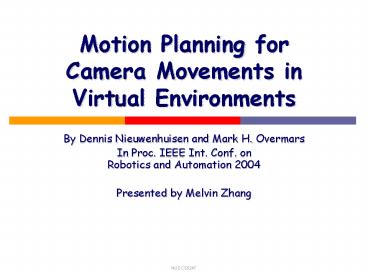Motion Planning for Camera Movements in Virtual Environments - PowerPoint PPT Presentation
Title: Motion Planning for Camera Movements in Virtual Environments
1
Motion Planning for Camera Movements in Virtual
Environments
- By Dennis Nieuwenhuisen and Mark H. Overmars
- In Proc. IEEE Int. Conf. on Robotics and
Automation 2004 - Presented by Melvin Zhang
2
Overview
- Motivation
- Related work
- Camera configurations
- Good cinematography
- Approach
- Handling the constraints
- Motion planning for camera movements
- Creating a roadmap
- Finding shortest path
- Computing camera speed
- Computing viewing direction
- Applications and experiments
- Summary
3
Motivation
- Camera navigation in virtual environments
- Computer games
- Architectural walkthrough
- Urban planning
- CAD model inspection
- Drawbacks of manual control
- Difficult
- Ugly motions
- Requires attention of user
- Solution Specify start and goal
- Automatically generate smooth collision free
motion
4
Related work
- Support motion generated by user
- Virtual sidewalk
- Speed of motion adapted automatically
- Computation of fixed camera positions
- Following a target
- Third person view
- Trajectory may not be known beforehand
- Similar to target tracking
5
Camera configurations
- Camera position - point in 3D
- Viewing direction - point in 3D
- Amount of roll - 1 parameter
6
Good cinematography
- Camera not too close to obstacles
- Horizon should be straight
- Lower speed when making sharp turns
- Speed as high as possible
- Visual cues to future movements
7
Approach
- Create probabilistic roadmap
- For each query, connect start and goal nodes
- Compute shortest path
- Smooth path
- Compute trajectory
- Shorten path
- Reduce number of segments
- Compute viewing direction
8
Handling the constraints
- Camera should not pass to close to obstacles
- Model camera as sphere
- Horizon should be straight
- Avoid rolling the camera
- Lower speed when making sharp turns
- Compute speed base on radius of turn
- Speed as high as possible
- Path should maximize speed of camera
- Visual cues to future movements
- Viewing direction of time t set to position in
time td
9
Creating a roadmap
- Consider camera as sphere
- Generate collision free camera positions
- Connect position c, c by checking if cylinder is
collision free
10
Finding shortest path
- Wide turns may be preferred over sharp turns
- Use a penalty function, p(e,e), which depends on
angle between e and e - Distance for e arriving from e is p(e,e)
length(e) - Compute shortest path using Dijkstras algorithm
- Complexity is O(VlogV)
11
Smoothing the path (I)
- Path consist of straight line segments
- Smooth path must be first order continuous
- Replace vertices along path with largest
collision free circular arc using binary search
12
Smoothing the path (II)
13
Computing camera speed
- Smooth path is not sufficient for smooth motion
- Speed should also change in a continuous way
- Max speed determined by arc radius
- Use max acceleration and deceleration to find
actual speed - Backtrack deceleration to guarantee bottom corner
- Accelerate maximally up to threshold or new edge
- Complexity is linear in number of segments and
arcs on path
14
Shortening the path
- As roadmap is coarse, shortest path in graph may
be shortened - Pick two random configurations
- Check for collision free path between them
- Compute camera speed
- Accept if new time is lower
- Remove nearby nodes to reduce number of segments
15
Computing viewing direction (I)
- Viewing direction should also be first order
continuous - Should indicate future motion
- At time t, look at position at time ttd
- Proved to be first order continuous
- Nearer in sharp turns and further in wide turns
16
Computing viewing direction (II)
17
Applications and experiments
- Implemented in CAVE C library
- Figure on the left is scene of Rotterdam
- Preprocessing in 2D (fixed height) took 5s
(Pentium 4, 2.4 Ghz) - Query any pair of positions in 0.5s
- Figure on the right is model of a building
- Preprocessing in 3D took 8s
- Query any pair of positions in 0.5s
18
Demo video 1
19
Demo video 2
20
Future work
- Generating human path
- Fixed height above ground
- Possibility of climbing starts/ladders
- Following target with known trajectory
- Account for obstacle occlusions of target
21
Summary
- Contributions
- Novel application of PRM approach for planning
camera motions - Formulated constraints imposed by theory of
cinematography - Developed various smoothing techniques to achieve
a smooth trajectory - Further improvements
- Penalty function p(e,e) not defined, shortest
path does not take into account camera speed - Collision check for circular arcs is time
consuming, currently approximate arcs using
number of short line segments - Path shortening needs to repeat adding of arcs
and computing speed diagram - Approach base on iteratively applying several
heuristics to improve the path, difficult to
judge amount of improvement - Formulate path improvement as an optimization
problem?































